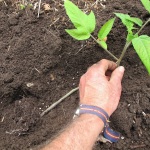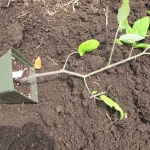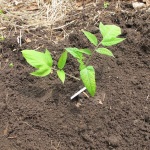June in the Vegetable Garden
I know gardeners who rush to get their veggies in the ground, starting spinach and peas in April, carrots, potatoes and more by mid-May and then tomatoes and all the rest by Memorial Day weekend. Not me. I’m just planting many things. Sure, my peas, planted in May, are about a foot tall. And all my root crops – beets, carrots, kohlrabi, leeks, onions and rutabaga are up and looking good. Let’s look at some other vegetables.
Organic corn seeds, the type I buy, are not treated with fungicides and so they might rot if planted in wet, cool ground – and that describes the type of soil I have right now. So here’s what I do: I plant them in “plug trays”. Mine are plastic trays with 98 growing compartments per flat, each a bit deeper than the standard 6-packs I use for starting veggies in flats. I fill the holes with a 50-50 mix of potting soil and fine compost and plant one seed in each.
Corn takes 10-14 days to germinate in cold, wet soil. Last year, the first time I grew corn in many years, my corn germinated on a heat mat in 3 days! I let it grow for a week or so, allowing the roots to fill the soil compartments of my plug trays and develop true leaves.
Then, on a hot sunny day in mid-June, I planted the corn seedlings in the field. It was quick work for two people: I crawled along on my hands and knees, planting corn every 8 inches; my partner, Cindy slipped the plants out of the flat and handed them to me. We allowed 30-36 inches between rows. If space is a constraint, you can plant rows 24 inches apart, but the ears will be smaller. In order to get good pollination, you must plant in blocks with at least 4 rows.
Crows are the bane of corn growers. They love the corn seeds that have just germinated and have some small leaves. By planting good-sized plants, the corn is less vulnerable. It only takes a day or so for the roots to develop the strength to resist crows, and the germinated seed is long gone.
A wise gardener who direct-seeds her corn told me that she sprinkles fresh grass clippings around her corn when it first germinates. The greenery disguises the seedlings, fooling the crows. She does that twice, allowing the corn to be well settled in. Slick!
June 10 is my usual day for planting tomatoes, though I’ve planted later, and the plants catch up quickly. I plant tomatoes deeply, or sideways. That way the long stems become shorter and less floppy, and the buried stems develop roots, providing more roots to absorb water and nutrients.
To plant sideways, dig a hole for the rootball and a trench for 6 inches (or more) of stem. Pinch off all the lower leaves and branches, just leaving the top leaves. Cover the rootball and stem, and turn the top up. The series of photos below shows each step.
This year I am not adding any fertilizer in the planting hole. Usually I add some bagged, slow-release organic fertilizer in each hole. But reading Carol Deppe’s book, The Tao of Vegetable Gardening, last winter convinced me that too much fertility encourages tall plants but less fruit. Maybe I’ll do some each way and see for myself.
The vine crops – cukes, zukes, winter squash and pumpkins – would be badly munched by striped cucumber beetles unless I take preventive actions. The dastardly beetles and eat the new cotyledon leaves in a single night! So now I start them in small pots indoors, and let them develop foot-long vines before I put them out.
I also cover my vine crops with Reemay or row cover when I plant them to keep those beetles off. I don’t bother using wire hoops to keep the Reemay off the plants, I just lay it down and pin the edges to keep it from blowing away. But I have to remove it when the plants flower, as they are insect pollinated. By then the plants are big enough to survive. Row covers are good for keeping flea beetles off broccoli, too.
Potatoes can be planted in May – or now. I plant in June, in part, because my soil is near a stream and is colder and wetter than many other gardens around. But I also do it so that the Colorado potato beetle will go to my neighbors’ potatoes instead of mine (sorry, Lois). That’s right, they will be munching away on the neighbor’s potatoes before mine even go in the soil.
I plant lots of beans, in part because they freeze so well that I can store them and eat them all year. I plant beans in mid-June when the soil is plenty warm – 65 degrees or more, and when nights are warm, too.
Nights in the 40’s or low 50’s are very discouraging for warm-season crops like peppers, beans and tomatoes. Egggplants hate chilly nights. You can place a dark-colored rock the size of a melon near each eggplant, and it will soak up heat during the day and kick it back at night. I do that for peppers sometimes, too.
Gardening is a dance I do with the weather, the birds and the bugs. Sometimes I get great harvests, other times I do not. Still, I consider myself blessed to have a plot of good soil, an amenable climate, and the good health to pull the weeds! I wish the same for you!
You may e-mail questions to Henry at henry.homeyer@comcast.net. His website is www.Gardening-Guy.com. His book, The New Hampshire Gardener’s Companion, is just out in an expanded 2nd edition.





